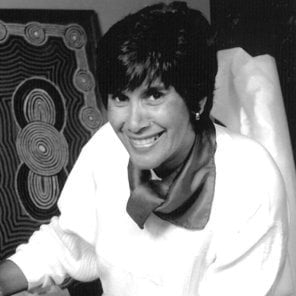
- Inducted:
- 2013
Valmai Heap was a Yorta Yorta woman whose accomplishments in life reflected a desire to give back to her community. Her influence in areas such as cultural heritage can still be seen today, while the glass ceilings she shattered exemplify her passionate advocacy for women.
Born in Carlton in 1943, Val was the daughter of Thomas Muir and Nellie Delahoy. Her parents were unmarried, which at the time made it difficult for her mother to care for her. Val's paternal grandparents, Louisa and Charlie Muir, adopted her when she was three months old.
Growing up in Shepparton, Val was surrounded by strong female relatives, each of whom helped shape her character. Her grandmother Louisa was politically astute and one of the first members of the Aborigines Advancement League. She instilled in Val a sense of pride in her Aboriginal heritage. A competent student, Val completed fourth form (year 10) at Shepparton High School. She found work as a secretary upon obtaining her Leaving Certificate in 1959.
When she was 17 years old, Val met a young man named Alan Heap at a dance. The two went on to marry, before relocating to New Zealand in search of employment opportunities. Leaving family and friends for a new country was a daunting prospect for the young Aboriginal woman, but Val was a pragmatist. She remained one her entire life.
Val and Alan's two children, Karen and Ian, were born in New Zealand. The family spent a number of years as lighthouse keepers in some of the most isolated locations in the country. It was not an easy life. There were no telephones or shops and access to the outside world was limited to a monthly visit from a supply boat. Val's ingenuity helped her to meet the needs of her family, while her parental responsibilities extended to overseeing the children's home schooling via correspondence.
After a period of time on the remote Chatham Islands, the family settled in Greymouth, on New Zealand's South Island. It was here that Val became engaged in activism for the first time, attending an anti-apartheid protest during a tour by South Africa's national rugby team. Her husband established a successful business selling the pottery he made, while Val returned to secretarial work. However, she too expressed herself artistically and was a weaver of considerable talent.
In 1982, Val and her husband followed their adult children back across the Tasman to Australia. Following a brief return to Shepparton, the couple settled in Clunes and Val successfully applied for a job in cultural heritage at the Ballarat and District Aboriginal Co-operative (BADAC). She quickly proved to be someone with clear vision and determination.
Within two years, Val was appointed Administrator of BADAC. It was a significant achievement in the days when female CEOs were rare; even the board members who appointed Val were all men. Val became a role model for women of all ages, Aboriginal and non-Aboriginal, as well as a symbol of the change that she believed women could enact together.
With her ability to listen and communicate effectively with the local Aboriginal community, Val's tenure as Administrator was a productive one. Compassionate and hard working, she helped develop health and legal services, childcare, cultural and educational programs, thereby strengthening the foundation on which BADAC has continued to build. Her valiant early efforts to promote wider understanding of Aboriginal culture, and to provide support for victims of domestic and family violence, were a precursor to future initiatives. Today, Val's daughter Karen continues the journey of her mother's work.
After a short time working as a drug and alcohol officer for the Victorian Government, Val relocated to Melbourne in 1988, to take on a newly created position at Museum Victoria. As Co-ordinator of Aboriginal Training, she once again broke new ground: it was the first time an Aboriginal person had been employed by the institution.
Val's work for Museum Victoria saw her travel the state, implementing programs that contributed to the preservation of artefacts, cultural traditions and stories. She helped assemble a collection that is exhibited to this day and is used to introduce Aboriginal and non-Aboriginal people to the history of Victoria's First Peoples.
As part of her work to promote recognition of Aboriginal women, Val secured funding to produce a number of exhibitions, books and films. Among these were the successful touring photographic exhibition Daughters of a Dreaming; a major book titled Living Aboriginal History; the film Koorie Culture Koorie Control; a film about the Cummeragunja walk-off that focused on the experience of three women and a film about the revival of fibre craft amongst Aboriginal women. Val continued her own weaving and textile art, while remaining a dedicated supporter of other female artists.
Val was appointed to the council of Museum Victoria and chaired its Aboriginal Cultural Heritage Advisory Committee. In 1986, she became the first female Aboriginal member of the Victorian Planning Appeals Board.
She used the opportunity to advance Aboriginal interests and promote better understanding of the problems faced by communities, in areas such as housing.
Val passed away in 1991. A trust was established in her honour to continue her work. In 2012, she was posthumously inducted to the Hepburn Shire Council Women's Honour Roll.
Unassuming in manner, Val's preference was to work quietly behind the scenes, without the need for recognition. However just as her contribution to Victoria cannot be understated, nor will it be forgotten.
Updated

